Migrating from DTA Version 1
If you are familiar with previous versions of DTA, use this section to learn about the main changes to version 2 of the product. The features of version 2, which are largely centred on responsiveness and accessibility, have resulted in significant improvements to the DTA user interface. These provide an even better user experience and cater for a wider audience.
Changes to User Interface Elements
DTA Browser Application (Slim Mode)
New Features
Notification Centre
This feature combines elements of the Broadcast Notification feature in DTA version 1 with new extensions that allow external applications to push notifications to DTA and combines them in a single Notification Centre Panel. By seeing important information in one place, you can work more efficiently by attending to tasks that require immediate attention. In the panel, you can:
- See notifications such as supervisor broadcasts, system messages, and real-time alerts generated by storm VIEW.
- (Supervisors only) See 'alert supervisor' messages sent by agents. See Alert My Supervisor, below.
- See the source and time of arrival of each notification.
- Manage notifications.
See also, View Broadcast Notifications, Broadcast a Message to Agents (supervisors only), and Respond to an Agent's Alert Message (supervisor's only).
Emergency Alerts
This feature allows a storm agent to quickly broadcast a highly visible and audible emergency alert to an agent group. Emergency alerts are intended for use in situations where agents in a group are required to rapidly respond to fast-changing and life-threatening incidents.
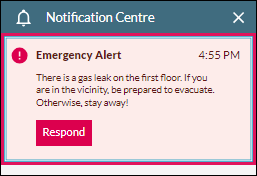
- An agent broadcasts an emergency alert message to all agents in the selected agent group.
- Each logged in agent's Notification Centre Panel opens automatically. The highlighted alert message and a Respond button are displayed at the top of the panel.
- An alert sounds if an agent in the group has not responded to the message in 30 seconds. Each agent hears the audio even if the DTA browser window is out of focus or if they are locked out of Windows. An agent can change the sound's audio device and volume in the Settings Window. If a device is not configured here, the audio plays through the PC speakers or the default audio device.
- When a receiving agent responds to the alert by clicking the Respond button, their Chat Panel opens automatically allowing them to quickly initiate a chat with the broadcasting agent.
- The name of the responding agent is immediately visible to the broadcasting agent and to every agent in the broadcast agent group (in their Notification Centre Panels).
- Emergency alert messages that have been responded to remain visible in the Notification Centre Panels of all agents in the group until they are deleted manually.
See also, Send or Respond to an Emergency Alert.
Alert My Supervisor
This feature allows a storm agent to quickly request support from a supervisor if they encounter problems in servicing a customer interaction. This is useful where an agent is encountering difficulties while servicing a customer interaction, or if they feel that their ability to service interactions is being adversely affected by stress or by feeling unwell.
- An agent can request support with the minimum amount of effort.
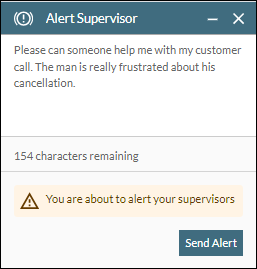
- The message is sent to all supervisors who manage that agent irrespective of whether they are logged in to DTA.
- A supervisor can respond instantly with a chat message.
See also, Send an Alert Message to a Supervisor.
Four-Way Conferencing
The four-way conferencing feature in DTA is oriented towards use cases where, while on a call with a customer, you engage an interpreter to help understand the customer's request, and then introduce a subject-matter expert to the call. You can then step out of the call while customer, interpreter, and expert address the issue. You may then rejoin the conference at a later point to bring matters to closure.
Using the new Conference Panel, you can manage a conference and its individual participants with ease. You can:
- Include up to four participants (including yourself, the conference owner) in a single conference.
- See the time at which a conference was initiated.
- Name a conference.
- Have multiple conferences running at the same time and participate in any one of them as required.
- See a list of all conferences in the Interactions Panel and use this to hide or display conference panels.
- Leave and rejoin a conference that you have initiated.
- Add a third or fourth participant with or without consulting with them first.
- Instantly remove a participant.
- End the conference for all participants.
See also, Create a Three- or Four-Way Conference.
Cobrowsing
The cobrowsing (collaborative browsing) feature allows you to work more closely with a customer during an interaction such as a voice call or web chat by interacting with a web page on the customer's device. Cobrowsing goes beyond traditional screen sharing as it allows you to resolve issues quickly and efficiently by guiding your customers through complex processes in real time where you can point, highlight, and draw on their shared web pages through the DTA Cobrowse Panel. The need to share files and links is reduced or eliminated as a result.
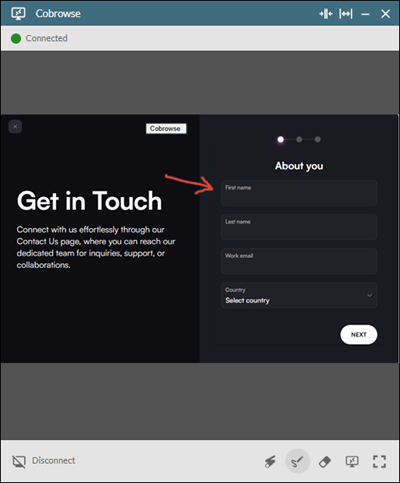
To initiate a cobrowsing session, your customer must first click the Cobrowse button on their website to generate a six-digit code for sharing with you. When you enter this code into the DTA Cobrowse panel, a message is sent to the customer prompting them to confirm the cobrowse session. When the session is initiated, the customer's shared web page is displayed inside your DTA Cobrowse panel, where you can perform actions that are reflected on the customer's device.
For cobrowsing to work, a cobrowse account must be set up by Content Guru. The web page hosting the Cobrowse button must be set up by your website administrator.
See also, Assist a Customer Over a Cobrowse Session.
Responsive Behaviour
In DTA version 2, the user interface elements adapt their layout to the size of the application window. Shown below is the DTA version 2 main application screen in a wide window:
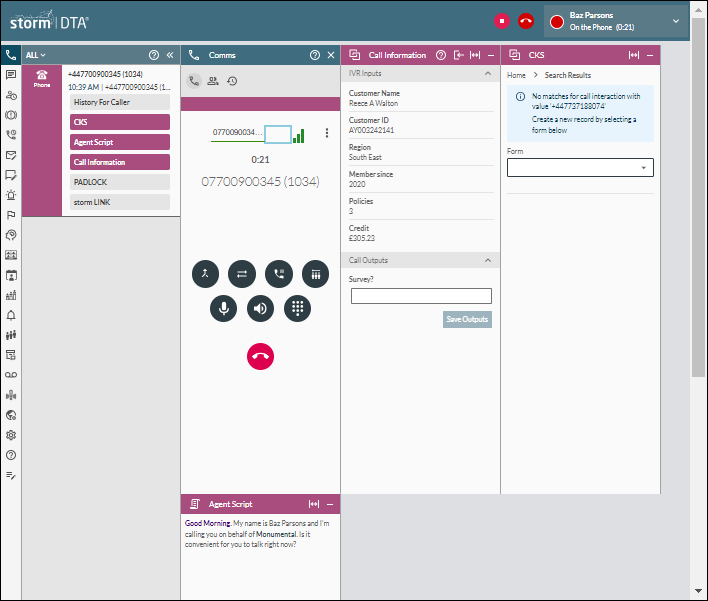
Reducing the window width results in the following layout change without any loss of functionality.
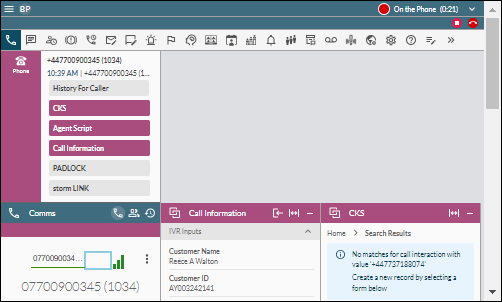
This allows DTA to run in desktop areas to suit users with smaller single-screen devices such as tablets and smaller laptop screens. A minimum window width of 320 pixels is supported at 100% zoom level.
See also, Responsive Behaviour.
Improvements to Accessibility
DTA version 2 is now compliant with Web Content Accessibility Guidelines (WCAG) v2.1 Level AA and this is assessed externally every 6 months.
|
Item |
In version 1 |
In version 2 |
|
Keyboard |
Not fully keyboard driven |
Fully keyboard driven |
|
Screen reader support |
No |
Yes |
|
Zoom level and text size |
Loss of functionality at high zoom level and large text size |
Zoom level: up to 400% without loss of functionality. This is subject to a display area effective pixel width of 320 pixels at a 100% zoom level and a browser window width of 1280 actual pixels (four times the minimum effective pixel width of 320). Support for text zoom to 200%. |
|
Contrast ratio |
No minimum |
Minimum 3:1 between adjacent user interface elements |
|
Focus display |
Use of 'in-focus' controls not fully supported across user interface elements. |
The control that is in focus is shown with a blue border across all user interface elements. |
|
Availability status |
Conveyed through colours only |
Conveyed through colours and symbols |
See also, Accessibility Features.
Panel Contextual Help
Many panels offer a  Help button for taking you directly to the help topic for that panel. From there, you can easily navigate to procedural topics associated with that panel.
Help button for taking you directly to the help topic for that panel. From there, you can easily navigate to procedural topics associated with that panel.
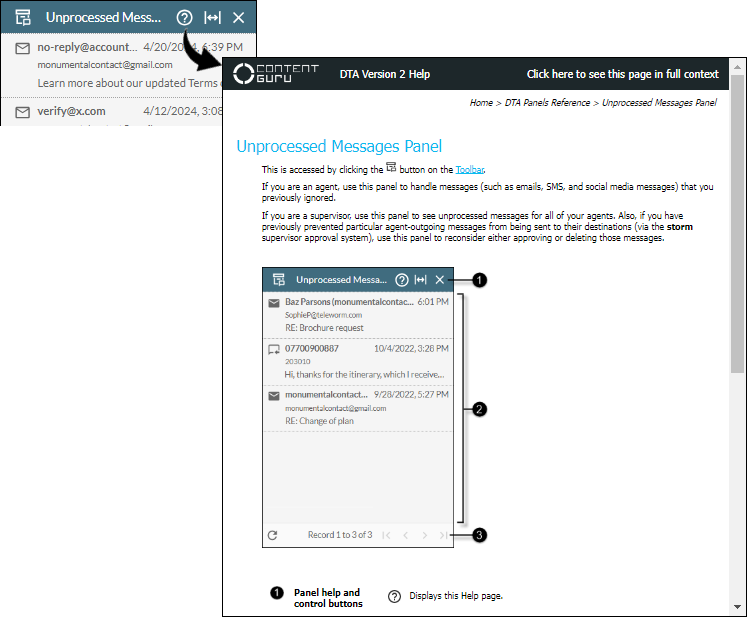
Customising Your Workspace
DTA version 2 allows you to rearrange panels in your workspace. This is not possible in version 1.
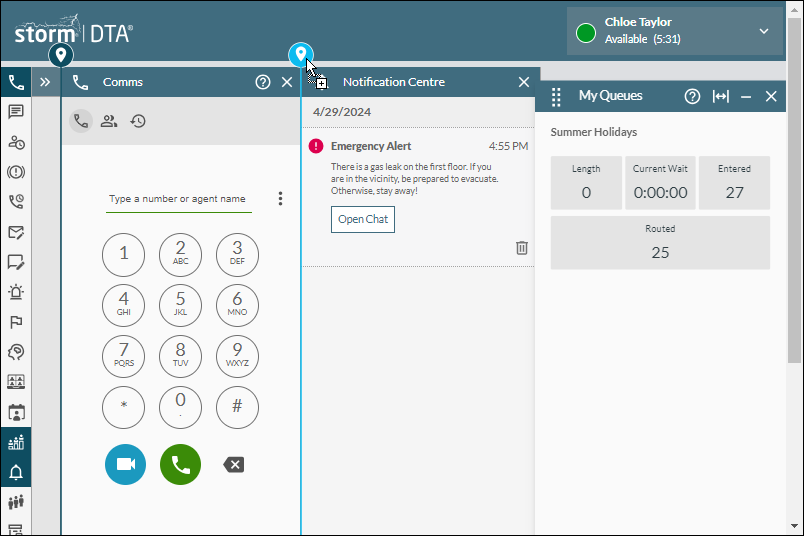
See also, Rearrange Panels in the Workspace.
Changes to User Interface Elements
This section describes the main changes to the DTA user interface elements in version 2.
|
Item |
In version 1 |
In version 2 |
|
Selectable availability statuses and buttons for most functions. |
Selectable availability statuses. All supported functions are launched from the new toolbar. |
|
|
Toolbar on the right of the screen for access to interaction tools such as Web iPath and chat. |
All interaction tools are launched from the new toolbar. Redesigned slim panels with no horizontal scrollbars. All functionality is now available in the panels (for example, completion code selection). |
|
|
Not supported. |
All interactions that you are engaged in are listed in a single panel. |
|
|
Functions such as call hold and call transfer are provided on an in-call panel bar below the main title bar. |
No call bar. Call information is displayed on the Interactions panel. In-call functions are provided on the new Comms panel in the workspace. |
Main Title Bar
This is the main title bar in DTA version 1 showing the buttons for accessing most DTA functions.

This is the main title bar in DTA version 2:

The Search field on the left of the title bar in version 1 was used to enter telephone numbers, search for contacts and for making outbound calls.
In DTA version 2:
- You search for contacts on the new Comms Panel - Contacts Tab.
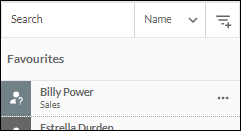
- You enter the destination number on the Comms Panel - Phone Tab. See also, Call by Entering the Destination Number.
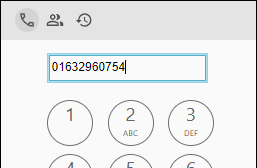
- The availability status is indicated by a colour-coded circle. See also, Main Application Window.
The main functions that were provided by the buttons in the main title bar of DTA version 1 are now launched from the new toolbar in version 2.
|
Version 1 button |
Purpose |
In version 2 |
|
|
For displaying your organisation's contacts list. |
The contacts list is displayed on the new Comms Panel - Contacts Tab. |
|
|
For displaying your conversation history. |
Your conversation history is displayed on the new Comms Panel - History Tab. See also, View your Personal Interaction History. |
 |
For viewing your personal voicemail messages. |
Personal voicemail messages are displayed on the new Voicemail Panel. See also, Listen to Your Personal Voicemail Messages. |
|
For accessing additional functions, changing DTA settings, and viewing the DTA online help. |
All functions, DTA settings, and the online help are available on the new toolbar. |
|
 |
For monitoring switchboard queues. |
All storm SWITCHBOARD functions are now available on the new toolbar. |
 |
For pairing DTA with a PSTN device or for initiating a DTA Web iPath call. |
PSTN-pairing and DTA Web iPath calls are performed on the new Comms Panel - Phone Tab. See also, PSTN Device Users and Make an Outgoing Call. |
Workspace
This illustration of DTA version 1 shows the toolbar on the right side of the screen for launching the Web iPath, chat and other interaction panels.
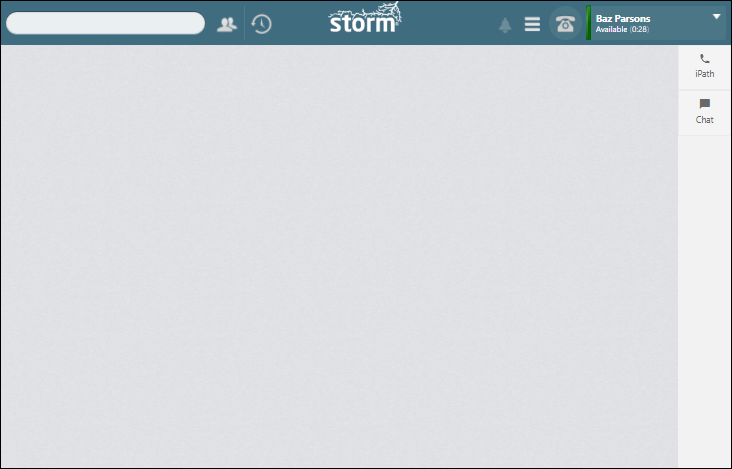
In DTA version 2, all functions are launched from the toolbar on the left side of the screen. Web iPath users no longer need to launch the keypad with a button as it is displayed automatically on the new Comms panel. You can rearrange the toolbar buttons.
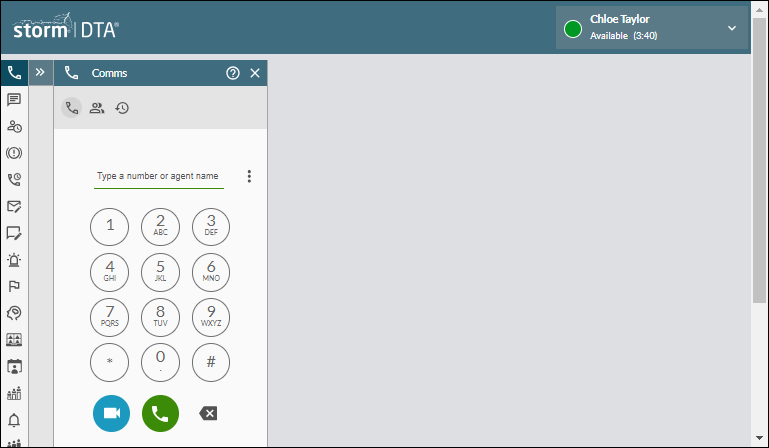
Call information can now be popped out in an adjacent panel:
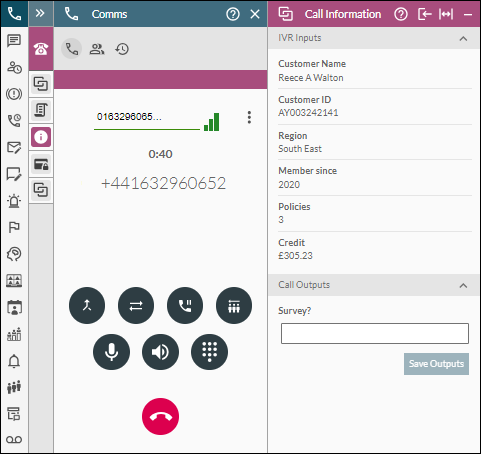
Completion codes are now also displayed for selection in the Wrap Panel instead of in a dialog:
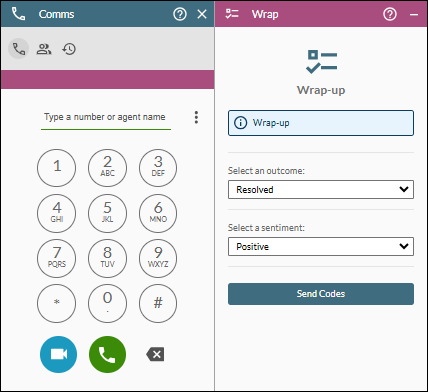
List of Interactions
The new Interactions Panel allows you to see the number of interactions you are actively engaged in.
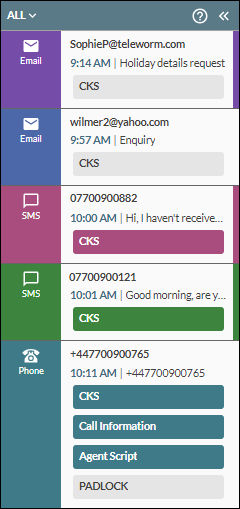
Call Information and Handling Functions
This illustration of DTA version 1 shows the in-call panel that appears during a call. The panel displays the call's details as well as buttons for handling the call.

In DTA version 2, the details of the interaction are displayed on the new Interactions panel:

In-call functions are available on the Comms Panel - Phone Tab.
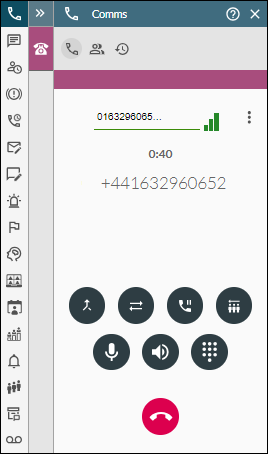
Recording Playback
The call recording playback function now offers better control of recording playback, with support for pause and resume, and the capability to start playback from any point in the recording.
DTA Browser Application (Slim Mode)
DTA version 2 can run as a desktop application without an address bar, toolbars, and browser tabs. When running at its minimum effective pixel width of 320 at a 100% zoom level, you can dock the window to the left or right of your screen to free up your desktop for other applications.
See also, Use DTA in Slim Mode.

